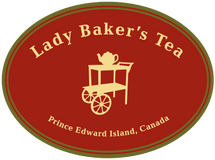What exactly is Orange Pekoe?
Without a doubt, the most popular question I get asked at the market booth is
"Do you have any plain old orange pekoe tea?"
For Maritimers, 'orange pekoe' is considered the traditional tea of choice!
I grew up on Red Rose Orange Pekoe tea never questioning what those two words, orange pekoe, meant? It's one of those accepted terms that we don't even notice! At the market I offer 'specialty' teas which are not available in the tea bag format. But I do have orange pekoe teas. So what is orange pekoe?
First of all orange pekoe is not an orange-flavoured tea nor in any way associated with the orange fruit!
Orange Pekoe is a classification of black tea based upon the origin of the leaf. To be classified as pekoe, the tea must be composed purely of the new flushes - a flush being the leaf bud plucked with two youngest leaves. (Any other leaves produce teas of lower quality.)
So...the orange pekoe term refers to a grade of black tea based on the size of leaf and its location on the tea plant.

Would you like that term 'orange pekoe' to make more sense?
Well, pekoe is actually pronounced 'pek-ho' and is derived from a word for a special kind of Chinese tea, meaning white downy hair referring to the down-like hairs on the tea leaves that are the youngest and smallest on the plant.
And the 'orange' part? It is most likely that the Dutch East India Company had something to do with this description. The Dutch royal family was of the House of Orange. In the 1600s the company brought teas to Europe and the best of the black teas was reserved for the royal family. When it was introduced to the public, it became known as the 'orange' pekoe, associating it with royalty!
Thus, a grading system with the term orange pekoe (OP) began.
But if only it were that simple!
We have FOP (flowery orange pekoe) - tea made from the end bud and first leaf of each shoot.
GFOP (Golden flowery orange pekoe) FOP with golden tips
TGFOP (Tippy golden flowery orange pekoe) FOP with a large proportion of golden tips.
Should I stop here? Can you guess what the grade is of FTGFOP? How about SFTGFOP?
I mentioned early in the blog that I carry orange pekoes. There are flavoured orange pekoes which I do have, but I was referring especially to the common traditional tea that people in the Maritimes tend to think of as 'just plain tea'. The two that fit this description are Ceylon (Sri Lanka) and Assam (India). They are TGFOPs! And both of these are from single organic estates, not blended with other leaves from estates in the area.
Most tea bags are made up of the fannings, the finest siftings of the processed OP teas. But that's another story!
I hope this has been helpful. Next time you drink your black tea, think about that beautiful downy leaf plucked by trained hands using the pads of the fingertips to give you that perfect cup you and I enjoy so much!

21 comments
I just want to say that I loved reading this. So insightful! Thank you.
Most of my life I had Tetley (India), Twinnings and Yorkshire tea but never heard of Orange Pekoe until I moved here. I have tried it and I don’t think its the same or even close. I did hear about Ceylon tea mostly in the middle east.
Hello and thank you for your blog post! So, from what you say, Orange Pekoe tea could be from anywhere? India, Ceylon, China? Or does it indicate origin too? I’m from England (now having lived in Canada for 18+ years) and had never heard of the term orange pekoe before I moved here!
This COVID situation is horrible. Normally when heading home to Canada, I have a suitcase dedicated to all things Canadian that I cannot get in the US – OP tea being at the top of the list. No other tea compares for me. I wish the US would become a little pickier about tea. It’s been 20 years for me, and unfortunately or maybe fortunately – OP tea will keep me coming back home to Canada!
In the southern US if you are visiting down here the one brand that is orange pekoe is “Luzianne”. You can find it in almost every grocery store. It is advertised for iced tea but if you read the ingredients it is Orange Pekoe And Pekoe Cut black teas. It definitely is different (and my favorite) as a hot or cold served tea.